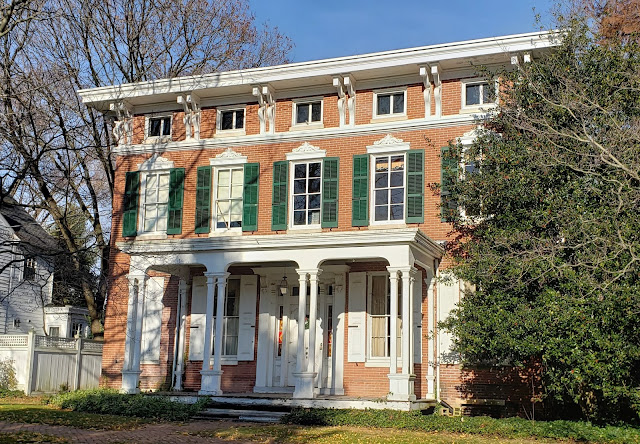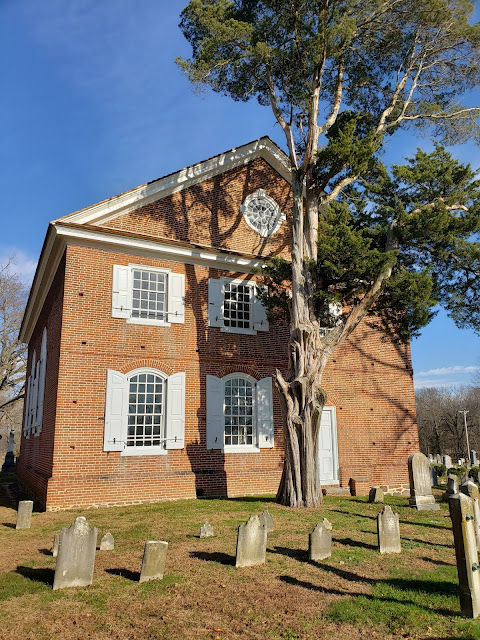Returning to Odessa: A Historic District Full of Treasures...and More Beyond It
 |
| Rear and side of Old Drawyers Presbyterian Church north of Odessa |
Odessa is probably best-known for the historic buildings owned by the Historic Odessa Foundation and called the “Historic Houses of Odessa.” I’ve talked about them in a separate blog post. But there are many other historic treasures in this National Historic District and its outskirts.
Odessa was
originally named Cantwell’s Bridge after Richard Cantwell, who began operating
a toll bridge over the Appoquinimink River in 1731.
 |
| Today's bridge over the Appoquinimink River--site of Cantwell's toll bridge |
Like many other towns along the Delaware Bayshore Byway, Odessa was a shipping port. In fact, in 1855 its name was changed from Cantwell's Bridge to Odessa in hopes of becoming another great port like the Russian seaport.
Adding to Odessa’s importance was a “Kings Road” that ran through Odessa from the Chesapeake Bay to the Delaware Bay. Odessa's Main Street--part of this King's Road--was thus a major thoroughfare. It was therefore designed as a wide boulevard to accommodate traffic to the Appoquinimink River wharf and beyond. Today Main Street’s broad lawns and huge trees provide an unusually elegant setting for a small river shipping town.
 |
| Main Street in Odessa |
Odessa’s importance as a shipping port declined in the late 1800s, when a railroad was built through Middletown, west of Odessa. Farm soil was worn out from overfarming, and a blight that I explain in this blog post decimated the peach industry. Since the late 1800s Odessa has been a residential community.
Noted Philadelphia architect Samuel Sloane designed several buildings in Odessa: the bank that I’ve discussed in my first Odessa blog post, the Academy at 315 Main Street, Old Saint Paul’s Methodist Episcopal Church at 506 High Street, and possibly the Cyrus Polk House at 303 High Street.
The delightful Academy was built in 1844 and was restored in
the 1930s by Rodney Sharp, whom I also discussed in my first Odessa blog post.
 |
| The Academy on Main Street in Odessa |
Cyrus Polk House at 303 High Street was built around 1853 in Greek Revival/Italianate style. Polk was a prosperous wheat merchant. Notice the beautiful brackets under the roof and the elaborate lintels over the second floor windows (which are made of cast iron). UPDATE 5/10/2021: This lovely house, also known as the Miller House after more recent owners, was gutted by fire on May 8, 2021.
 |
| Cyrus Polk House in Odessa |
Old Saint Paul’s Methodist Episcopal Church at 506 High Street was built in 1851. Its architectural style has been described as Greek Revival or Greco Egyptian.
 |
| Old St. Paul's Methodist Episcopal Church in Odessa |
Also on the western side of Odessa is the Appoquinimink Friends Meeting House or Quaker Meeting House at 618 Main St.
 |
| Appoquinimink Friends Meeting House on the outskirts of Odessa |
One of the smallest public places of worship in the United States, it was built in 1785 and restored by Rodney Sharp in the 1930s. It was probably a stop on the Underground Railroad, with escaped slaves hiding in the loft. Harriet Tubman may have visited here. Worship services resumed in 1946 and continue today.
In front of the Meeting House on High Street is Zoar Methodist Episcopal Church, a Gothic Revival church built around 1881. UPDATE 3/23/2025: Preservation Delaware points out that this was a church for African Americans. The original church, established in 1845, was an Underground Railroad stop for enslaved Black people seeking freedom in the North. Charles Albert Tindley, known as the grandfather of gospel music, was pastor of this church from 1889 to 1891. According to Wikipedia, Tindley's gospel hymn "I'll Overcome Someday" is credited by some as the basis for the civil rights anthem "We Shall Overcome."
 |
| Zoar Methodist Church in Odessa |
Odessa has dozens of other interesting historic buildings, and we’ll need to come back to explore them. On this trip, two particularly caught our eye. The first was what’s called Mrs. R. Metts or Ennis House on Main Street.
 |
| Mrs. R. Metts or Ennis House in Odessa |
At first glance this looks like a Gothic house built in the late 1800s, with a steep gable, pointed window, and gingerbread trim. But if you look past these, the house itself is a simple design--too simple to be Gothic. It was built in the early 1800s, probably in two sections (left side first, then right side added later). When we visited Leipsic, we learned that people living there in the late 1800s liked to update their older homes with the latest trim. That’s what happened here too.
Another interesting house is the Leftovers House, to the
right of Cantwell’s Tavern on Main Street.
 |
| Leftovers House in Odessa |
The Leftovers House may look like a Colonial-era house, but it's not. It was built by Rodney Sharp in 1955 from historic materials left over after his restorations of other Odessa buildings. So, while it’s made of historic materials, it’s not a historic building!
UPDATE 4/23/2021: Someone on Facebook kindly shared the photo below. This Second Empire building was on the site of the Leftovers House. Legend is that it was torn down because its architecture wasn't "in keeping" with nearby Colonial buildings. That reinforces the stories I read that Rodney Sharp wanted to turn Odessa into another Colonial Williamsburg. Notice that the right side is a store.
On the outskirts of Odessa are four more interesting historic sites. On Route 13, just north of Odessa, is Old Drawyers Presbyterian Church.
 |
| Old Drawyers Presbyterian Church north of Odessa |
Old Drawyers was built between 1707 and 1733 (sources give varying dates). It’s been called one of the finest Georgian churches in America. Like Barratt’s Chapel outside Frederica, its side walls have a nice pattern of “putlog holes”: inset bricks where scaffolding could be placed when the building needed repairs. Its “bulls-eye” windows are rare in Delaware.
 |
| Side view of Old Drawyers Presbyterian Church |
Southwest of Odessa, Noxontown Road take a sharp bend just south of the Appoquinimink River and just north of Noxontown Pond. There was once a village here named—you guessed it—Noxontown. All that’s left of the Colonial village is a mill probably built in the early 1700s. Note that the mill is on private property. It’s marked on Google Maps as “The Old Mill.”
 |
| Noxontown Mill |
A half mile east of Odessa, at 602 State Road, is Fairview, also known as the Major James Moore House, built around 1773. Moore was an officer during the Revolutionary War, an (obviously successful) wheat farmer…and a slave owner.
 |
| Fairview, east of Odessa |
Fairview is a nice example of Georgian architecture and, unlike many historic homes, hasn’t been altered much over the years. If you look closely, you can see several rows of bricks (a “course”) between the first and second stories and beautiful trim around the door.
A bit farther east, at 326 Thomas Landing Road, is David Wilson Thomas House, built around 1820. (The two additions on the left are modern.) It’s actually
a brick house now covered by siding.
 |
| David Wilson Thomas House outside Odessa |
David Wilson Thomas House was built by Samuel Thomas, a merchant and landowner, for his son David. While this house was built on farmland owned by Samuel Thomas, the Thomases weren’t really farmers. Like other wealthy landowners in this area, they hired managers and tenant farmers to do the actual work of farming. This house obviously isn’t as elaborate or finely detailed as Fairview or Corbit-Sharp or Wilson-Warner Houses in Odessa (historians call those high-style and this house vernacular). But in this region bricks had to be made on site, so brick homes were typically built only by wealthy people.
We’re looking forward to our next trip to Odessa to explore
more of the historic treasures here.





Lovely photos!
ReplyDeleteThank you so much! They're just snapshots with my phone, sometimes cropped a bit. I just try to pick sunny days for our roadtrips so the colors pop. It's amazing how many buildings along the Delaware Bayshore Byway face north, putting them always in shadow and making it hard to get a good photo of them! (See the Zoar Methodist Church in this post, for example.)
DeleteLinda, you do a lovely job, photos and text. Very inviting. Appo. Friends Meeting was the meeting of abolitiinists and Underground Railroad agents, John Hunn and his cousin, John Alston. Their selfless work is documented. What is not documented to date is the use of the meeting house to hide freedom seekers. Maybe some day, but not yet.
ReplyDeleteThank you for sharing this info on the Friends Meeting House! Very interesting!
Delete